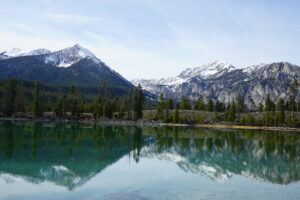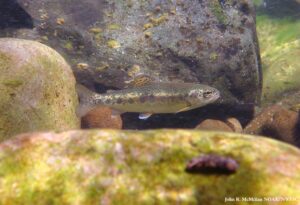After a busy spring and summer of young salmon leaving Idaho and adults coming home, fall is a time for taking stock. Biologists for the Shoshone-Bannock Tribes will survey Pettit Lake, high in Idaho’s Sawtooth mountains, to count sockeye salmon. These fish traveled 900 miles and climbed 7,000 feet through hot, inhospitable waters to return to their ancestral home and build their nests, called “redds.” The Tribes survey these redds to calculate how many fish were successful in making the epic journey home to foster a new generation. The number of fish is miniscule compared to historical abundance – just 46 wild sockeye made it back to Idaho this year, compared to an estimated 150,000 that once came back annually.
Still, without nearly 30 years of work by the Tribes and State of Idaho, these fish would be extinct. These efforts have forestalled extinction and kept the legacy of wild sockeye alive in Idaho, but to truly recover them, a change further downstream is needed.
Thankfully, the last months have brought promising signs that change is coming.

Over the course of nine months, Washington, Senator Patty Murray and Governor Jay Inslee undertook an evaluation of the services provided by the four dams on the lower Snake River that are driving our wild salmon and steelhead to extinction. They considered the devastating effects of these dams on fish, the resulting harms to Northwest Tribes and other communities, and how the services provided by these dams could be replaced. In August, they released a final report with recommendations on how to move forward.
These recommendations include replacing everything the dams provide so that breaching the dams and river restoration can be pursued in the future. They concluded that extinction of salmon is “categorically unacceptable” and that breaching the dams would be the most beneficial action possible for Snake River salmon. In laying out next steps, Murray and Inslee prescribed a program to replace all the benefits provided by the dams, and rejected the notion that removing the dams means compromising on the region’s goals for reducing carbon emissions.
What’s needed now are meaningful next steps to invest in infrastructure that replaces the dams’ services. We need renewable energy generation that serves the region’s needs into the future. We need a transportation system for grain that works for growers and shippers. Most of all, we need these things on a timescale that works for fish.
Meanwhile, in Washington D.C., the Biden Administration began to show its willingness to recognize that the current system is simply not working. Months ago, the White House Council on Environmental Quality opened the door to an alternative approach, stating, “We cannot continue business as usual.” Since then, agencies have completed dozens of listening sessions with Northwest Tribes and other groups to understand their needs and desire for fundamental change. The Administration’s efforts led to a temporary pause in the litigation over dam operations in the region, allowing dialogue focused on real, long-term solutions to save our wild salmon and steelhead.
As part of this new approach, the National Marine Fisheries Service, which manages the recovery of Idaho’s salmon and steelhead, evaluated what actions are needed to restore these fish to abundance. Using goals agreed to by the whole region – utilities and agriculture groups included – and over 20 years of scientific analysis, the agency concluded that, “For Snake River stocks, the centerpiece action is restoring the lower Snake River via dam breaching.” The Administration has agreed that in order to meet goals for recovery, dam breaching will need to be the foundation of a broad suite of actions.

In the coming weeks, we expect decisions from the Administration on how it will adequately fund fish recovery programs in the near term to forestall extinction, how it will address a $1 billion backlog of deferred maintenance projects at Northwest hatcheries, and how to build energy and transportation infrastructure that will replace the lower Snake River dams. We also expect Sen. Murray, Gov. Inslee, and other Northwest elected officials to do their part by conducting more studies of transportation and irrigation systems that will function without the dams, ensuring no communities are left behind.
We also expect this Administration to move away from the 2020 Columbia River System Operations Environmental Impact Statement (CRSO EIS), a document that prescribes how the system of hydroelectric dams on the Columbia and Snake rivers will operate. The plan is illegal, and will not lead to recovery of Idaho’s wild salmon and steelhead. As part of a move toward dam breaching, the Biden-Harris Administration must rescind their commitment to the status quo and make preparations for breaching of the lower Snake River dams.
Finally, we look forward to continued leadership from Idaho’s Rep. Mike Simpson, who remains outspoken in support of dam breaching and making all communities whole. Simpson, whose Columbia Basin Initiative legislative proposal was released nearly two years ago, remains an ardent supporter of Idaho’s salmon, recently stating, “I believe we can save salmon and protect farmers and all stakeholders without having to pick winners and losers.” When we take stock a year from now, we hope we can all count ourselves winners – including Idaho’s fish.
You can take action yourself for our wild salmon and steelhead above, or sign up for our Salmon & Steelhead Campaign updates here.

